Varieties of the 1714 Mexico City 8 Escudos
by Phillip Flemming
For reasons that remain unclear the Mexico City mint experimented exuberantly at the end of the War of Spanish Succession with novel designs for its gold coinage. From 1711 through 1713 ornate crosses and tressures paired with elaborate Bourbon shields and crowns to create new designs of some artistic merit. This experimentation had to have been approved by the new viceroy, Alencastre, Duke of Linares, though no viceregal directives have yet emerged from the archives. In any case, these designs proved unpopular in commerce and were quickly canceled by officials of the viceroyalty. In 1714 Mexico City settled on simplified designs that with only minor alterations would become standard for the remainder of the cob era (1715-32). In 1714 the mint mark Mo also permanently replaced MXo on all gold denominations. No 1713 dies were carried over to the 1714 coinage.
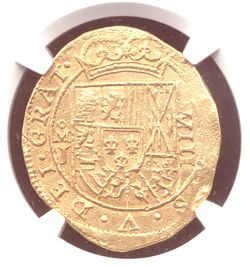
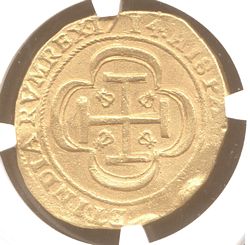
The new and simplified designs for 1714 were for the most part established at the beginning of the 1714 coinage. The new cross and crowned shield that constituted the major devices of the coinage did not change during the year. There was, however, some on-going experimentation/variation in the legends and with other minor die features. On the first onza dies used in 1714, for example, the date was consigned to the cross side (peninsular-style) with GRAT conspicuously replacing it in the shield side legend. No die study has yet tracked the other changes that followed in 1714, but it now seems possible to do so with high confidence. Before turning to that business it is useful to reflect on a few neglected facts about the Mexican gold cob coinage throughout its 55 year tenure.
From its inception in 1679, and even as early as the first discussions of the 1660s, Mexico City’s gold coinage was designed to be a strictly regulated coinage. Among other regulations a cap was imposed on its annual production. No other Spanish colonial mint had its gold (or silver) production capped in this fashion. Apparently the major advocate of this cap was the Mexico City consulado itself, the merchant’s guild, who found it more profitable to deal in gold bullion. Even with the consulado defending the cap it is not clear why the Mexican economy was content to labor under this handicap, particularly as Mexico’s annual gold production continued to rise in the post-Fleet era. For the entire cob period (1679-1731), except for 1694-95, the official cap remained at a stingy 1,165 marcos of gold (equivalent to 158,440 pesos). As the gap between what Mexico was mining and what it could mint kept growing, the Mexican economy must have worked with the ever-increasing supply of uncoined gold bullion in ways we do not understand. Archival work by Jorge Proctor is pursuing this question.
Recent archival work by Guillermo Cespedes del Castillo confirms that Mexico City’s gold coinage in 1714 was at the official cap of 158,440 pesos. Cespedes’ mintage figures do not include a breakdown by denomination or the delivery dates in 1714. It is not known whether fixed ratios of the gold denominations were also prescribed at Mexico City. No fixed ratios were observed in the gold coinages at Lima or Santa Fe de Bogota.
PradeauA. F. Pradeau, Numismatic History of Mexico, Los Angeles, 1938, p. 56 represents the annual gold mintage for the period 1696 through 1732, including 1714, as a constant 200,000 pesos. Pradeau does not discuss the obvious cap that his numbers reflect. The sources Pradeau used are alluded to earlier in his book (p. 47) and are clearly of mixed reliability. Cespedes’ better sourced numbers, depending on documents from both Spain’s Archives of the Indies (AGI) and Mexico’s national archives (AGN), should now be preferred to Pradeau’s. As Lazo Garcia has shown in the case of the Peruvian mints, Spanish colonial mints normally kept records of their coinage by denomination and delivery. It is possible that the exact mintages by denomination and the production/delivery dates of the 1714 gold coinage lie undiscovered in AGNM documents. This information would be very useful in confirming the die study we are about to present. Cespedes helpfully identifies the AGNM volumes in which to begin this search. Archivists please take note.
Perspective on the size of the 1714 gold coinage can be had from several comparisons. 158,440 pesos of gold is dwarfed by the 1714 Mexican silver coinage of almost 2,647,000 pesos. By value only 5.65% of the 1714 Mexican coinage is in gold. The Mexican gold issue is also small in comparison with contemporary Santa Fe and Lima gold issues. Santa Fe reported struck 386,240 pesos of gold in 1714 and Lima reported 718,283 pesos in a down year. Peru produced more gold than Mexico, especially after 1705, but Mexico’s gold production was not at the level of one fifth of Peru’s. Mexican gold production had increased significantly at San Luis Potosí, Guanajuato and Guadalajara by the end of Carlos II’s reign. We lack good data on Colonial Mexican gold production but one academic study estimates an average of at least 1.8 tons per year in this period. If this is correct, a large percentage of Mexico’s gold production went uncoined, more than an inconvenience for the Mexican commerce.
To understand what 158,440 pesos represents in actual gold coinage, imagine that this entire mintage was struck in onzas. Then 9,902 onzas would have been produced. We know from 1715 Fleet salvages that a respectable number of two escudos plus some one and four escudos were also struck in 1714 so the 1714 gold coinage was not all onzas. We know from the only other Spanish Colonial mint that struck a large onza coinage in this period that the complementary minor gold denominations were always a small part of the total mintage. In 1714 95% of Lima’s gold coinage was struck as onzas. That percentage only increased in the post-Fleet era and the 1710-15 average was over 96% of the gold coinage as onzas. If we apply these percentages to Mexico, then 95% of Mexico’s 158,440 gold pesos would comprise a mintage of 9,407 onzas and 90% of 158,550 pesos would be 8,912 onzas. As a reasonable estimate of the 1714 Mexican onza coinage let’s assume that it was likely in the 8,900-9,400 range. A mintage of this size, we can immediately infer, could easily have been accomplished with two pairs of 1714 onza dies. The similarly sized 1713 Mexican onza coinage seems to have been accomplished with two pairs of dies. Because of the small mintage, then, we should expect to encounter a small number of onza dies, unless other considerations complicated the 1714 gold mintage.
What follows is an attempt to reconstruct the 1714 onza coinage based upon die links and some assumptions about how the Mexican coiners reacted to the problems they evidently encountered in 1714. More complicated reconstructions are always possible, but the evidence of the coins themselves now suggests that four shield dies and five cross dies were used for the 1714 coinage. That means that on average about 2,300 and 2,000 onzas were struck per obverse and reverse die respectively, very low numbers which imply that the working life of most 1714 dies were prematurely curtailed by factors other than wear. Here in outline is our reconstruction.
Variety 1. Date on Reverse with GRAT in normal obverse date position.
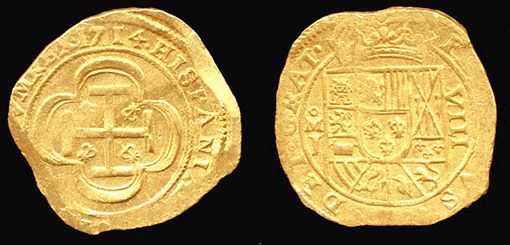 By die linkages this is the first set of dies employed in 1714. We have already illustrated an exceptional example of this coinage above. At the very beginning of the coinage Mexico may have attempted some special, nearly round strikings with its new designs for 1714. Schulman in 1972 called a similar specimen (lot 484) an “almost royal”, recognizing that it was clearly different from other examples of this variety. A more typical mint state example of this date-on-reverse variety is illustrated on this page. Whether by error or as an experiment, the date was engraved Spanish peninsular-style in the legend above the cross. GRAT took the normal place for the date in the obverse legend. If this was a deliberate experiment, as we are inclined to believe, it was probably a well-intentioned effort to make the king’s name, the denomination (VIII), and the date all visible on the coin. PHILIPPUS and the VIII denomination faced the date and mint mark on opposite sides of the shield. Mexican onza planchets were often small (28-30 mm). A clear date on one side meant no PHILIPPUS or denomination visible on the other, and vice versa. In principle moving the date to the reverse ended this competition for space. Unfortunately, after a session of minting with the new dies, it was discovered that 80-90% of the onzas struck showed no legible date on the reverse. The problem was that Mexico was still hand striking its gold coinage on poorly shaped and prepared planchets, rarely achieving more than partial cross side legends. Spanish-style dies were not compatible with Mexican-style production. No date on the onzas was a situation completely unacceptable to Mexican mint officials. The solution quickly arrived at was to return the date to the obverse legend, where with a slightly offset striking a legible and even bold four digit date could be achieved. Most 1714 onzas struck with a dated obverse die show this right offset (as do 1713 onzas).
By die linkages this is the first set of dies employed in 1714. We have already illustrated an exceptional example of this coinage above. At the very beginning of the coinage Mexico may have attempted some special, nearly round strikings with its new designs for 1714. Schulman in 1972 called a similar specimen (lot 484) an “almost royal”, recognizing that it was clearly different from other examples of this variety. A more typical mint state example of this date-on-reverse variety is illustrated on this page. Whether by error or as an experiment, the date was engraved Spanish peninsular-style in the legend above the cross. GRAT took the normal place for the date in the obverse legend. If this was a deliberate experiment, as we are inclined to believe, it was probably a well-intentioned effort to make the king’s name, the denomination (VIII), and the date all visible on the coin. PHILIPPUS and the VIII denomination faced the date and mint mark on opposite sides of the shield. Mexican onza planchets were often small (28-30 mm). A clear date on one side meant no PHILIPPUS or denomination visible on the other, and vice versa. In principle moving the date to the reverse ended this competition for space. Unfortunately, after a session of minting with the new dies, it was discovered that 80-90% of the onzas struck showed no legible date on the reverse. The problem was that Mexico was still hand striking its gold coinage on poorly shaped and prepared planchets, rarely achieving more than partial cross side legends. Spanish-style dies were not compatible with Mexican-style production. No date on the onzas was a situation completely unacceptable to Mexican mint officials. The solution quickly arrived at was to return the date to the obverse legend, where with a slightly offset striking a legible and even bold four digit date could be achieved. Most 1714 onzas struck with a dated obverse die show this right offset (as do 1713 onzas).
When the date was returned to the shield side, the 1714 dated cross die was retired. Apparently Mexico City wanted no double date 1714 onzas. Instead of simultaneously retiring the original GRAT obverse, it was decided for some reason to try to salvage that die by engraving 1714 over GRAT in the legend, creating, as we shall see, the second variety of 1714. The Florida State Collection, by the way, has more than a dozen examples of the date-on-reverse variety, only two with legible dates (see FL # 11.00039). Something over a dozen examples with full or nearly full reverse dates have appeared in the marketplace in the last 30 years. All appear to be 1715 Fleet coins.
Many date-on-reverse 1714’s, as we noted, have no legible legends. Diagnostics that can be used to identify the date-on-reverse dies on legendless coins include, on the shield side, an overstruck denomination VIII/IIIV and “ears” on the fesse of Austria (left side of the shield). The tallador initially punched in the denomimation backwards and also put the fleurs of Burgundy on the wrong side of the coin (in the space for Austria). The corrections he was required to make did not efface the obvious errors. On the reverse the fleurs in the angles of the cross have a distinctive “jellyfish” shape. 1714 is the last year we see “jellyfish” fleurs on Mexican escudos. A second cross die also used a different style of “jellyfish” fleurs to strike almost all of the normally dated 1714 issues. For comparison, we offer a side-by-side comparison of standard fleurs (right) with the “jellyfish” fleurs used on the date-on-reverse die.
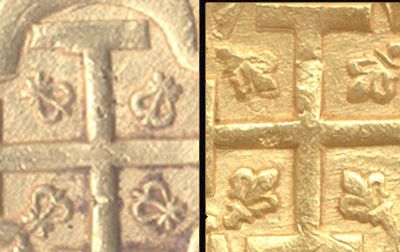
Variety 2. Date engraved over GRAT (same shield die as previous but recut), new dateless reverse (2nd) introduced with traditionally shaped fleurs.
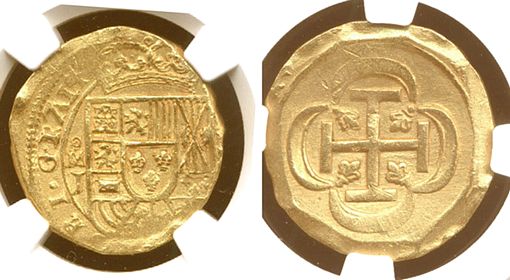 The tallador who was ordered to engrave 1714 on the GRAT obverse probably did not efface the GRAT for fear of fatally weakening the die. Yet it was not a worn die: shield and crown show no significant loss of high-point detail on any date-on-reverse coin. In any case, the resulting jumble of letters and shallow digits could not have pleased anyone, and it was not, judging by the scarcity of the 1714/GRAT issues, very successful in preserving working life of that obverse die. Notice also that the new reverse reverts to a design with traditional fleurs in the angles of the cross. Florida State has about a half dozen examples of this variety, only one of which (FL # 11.00421) shows the 1714/GRAT overstrike with some clarity.
The tallador who was ordered to engrave 1714 on the GRAT obverse probably did not efface the GRAT for fear of fatally weakening the die. Yet it was not a worn die: shield and crown show no significant loss of high-point detail on any date-on-reverse coin. In any case, the resulting jumble of letters and shallow digits could not have pleased anyone, and it was not, judging by the scarcity of the 1714/GRAT issues, very successful in preserving working life of that obverse die. Notice also that the new reverse reverts to a design with traditional fleurs in the angles of the cross. Florida State has about a half dozen examples of this variety, only one of which (FL # 11.00421) shows the 1714/GRAT overstrike with some clarity.
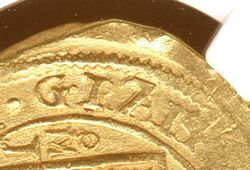 Pictured here is an enlargement of the overstrike from a coin in private hands. About a half dozen examples of this variety showing a clear 1714/GRAT overstrike have surfaced in the last 30 years. All of these are Fleet coins and apparently come from the Douglass Beach site, said to be the wreck site of the Mexican Fleet patache Nieves.
Pictured here is an enlargement of the overstrike from a coin in private hands. About a half dozen examples of this variety showing a clear 1714/GRAT overstrike have surfaced in the last 30 years. All of these are Fleet coins and apparently come from the Douglass Beach site, said to be the wreck site of the Mexican Fleet patache Nieves.
Variety 3. New obverse die (2nd) with date in normal position, initially paired with the previous traditional fleurs cross die (2nd), but soon with a new reverse die (3rd) featuring “jellyfish” fleurs. 1714 onzas struck with this obverse are commonly called the “normal” variety of 1714.
The recut 1714/GRAT obverse did not last very long before the overstrike became an illegible mess. The digits of the overdate, especially the final 14, were clearly not engraved deeply enough. When the die failed or was withdrawn for other reasons the Mexican coiners were able to turn to a new obverse die with the date in normal or standard position. Besides returning the date to the obverse the new die incorporated several other small changes including a slightly simpler crown. Surprisingly, the little-used previous cross die also did not last long (judging by the rarity of this sub-variety with traditional cross fleurs). Schulman (1972) lot 309 is one of the best example of the new normal obverse and the traditional fleurs reverse. Florida State has nearly twenty examples of the normal variety, about one quarter of them with full or partial dates. In the example illustrated notice the slight right offset, again sacrificing right legends (PHILIPPUS) for a clear full date.
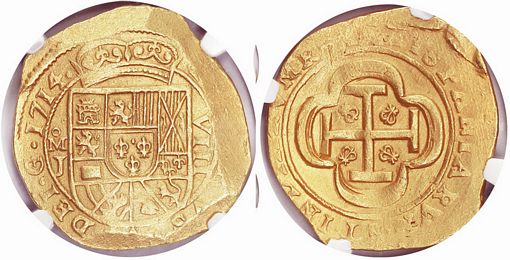
(courtesy Daniel Frank Sedwick)
Variety 3a. Normal shield die with “small 4”, same “jellyfish” cross die.
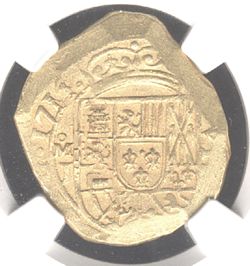 Some collectors believe these coins (about four are now known) are from different dies than the previous. Other collectors think it was just a matter of doubling in the legend and shield. Four coins with the identical features point to a problem with the dies, not the striking. What we see on this coin is an obverse die beginning to fail in the area of the date on otherwise a fairly new die. Much of the 4 is gone. A crack runs down from the second 1 into the inner border. Some of that border and the left boundary of the shield is failing. Not long after this coin was struck a significant portion of the die in the area of the date failed completely. What did the Mexico City mint do when its normal 1714 shield die failed unexpectedly?
Some collectors believe these coins (about four are now known) are from different dies than the previous. Other collectors think it was just a matter of doubling in the legend and shield. Four coins with the identical features point to a problem with the dies, not the striking. What we see on this coin is an obverse die beginning to fail in the area of the date on otherwise a fairly new die. Much of the 4 is gone. A crack runs down from the second 1 into the inner border. Some of that border and the left boundary of the shield is failing. Not long after this coin was struck a significant portion of the die in the area of the date failed completely. What did the Mexico City mint do when its normal 1714 shield die failed unexpectedly?
Variety 4. Obverse (3rd) struck from a Royal die, same “jellyfish” reverse die as previous.
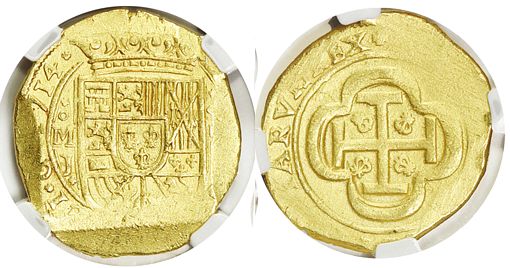
(courtesy Daniel Frank Sedwick)
What the coiners did at this point is surprising. Continued use of the previous cross die with a new Royal obverse die suggests that at this point the mint chose to press a Royal die into service to strike ordinary onzas. This was a highly unusual if not unprecedented move and would only have happened if Mexico City had no other 1714 shield die available to finish a scheduled delivery. The continued reverse die can be identified on the coin illustrated by a tightly spaced EX followed by a fat cross used as the stop. On several coins this reverse seems fairly worn. The obverse Royal die has many distinctive features including small crosses used as legend stops and flanking the shield. Two examples of this variety are attested, including one that was in in the Florida State Collection (FL # 11.00042) until traded away in 1977!
Variety 5. Both obverse and reverse (4th) struck from Royal dies.
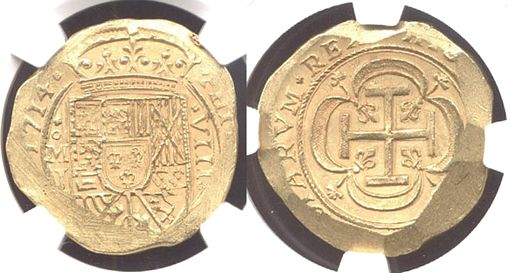 Not long after the Royal obverse die had been sacrificed to business production the worn cross die also failed and had to be replaced. Since the Royal obverse die had already been used for business production it was not a hard decision to press the Royal reverse die into service alongside the Royal obverse. Arguably the best of the five known example of this remarkable variety is pictured below. Its closest rival sold in April of 2012 for almost $49,000. Another lesser example with almost no date and a boxy, faceted planchet sold recently (10/13) for $29,375. The worst example of this rarity was lot 5135 in the 1977 Blauvelt-Fleet sale. Ponterio had the final example in his September 1996 sale. Florida State does not have an example of this variety. Please see the addendum below for a discussion of a unique non-business strike from these same Royal dies.
Not long after the Royal obverse die had been sacrificed to business production the worn cross die also failed and had to be replaced. Since the Royal obverse die had already been used for business production it was not a hard decision to press the Royal reverse die into service alongside the Royal obverse. Arguably the best of the five known example of this remarkable variety is pictured below. Its closest rival sold in April of 2012 for almost $49,000. Another lesser example with almost no date and a boxy, faceted planchet sold recently (10/13) for $29,375. The worst example of this rarity was lot 5135 in the 1977 Blauvelt-Fleet sale. Ponterio had the final example in his September 1996 sale. Florida State does not have an example of this variety. Please see the addendum below for a discussion of a unique non-business strike from these same Royal dies.
Variety 6. New obverse (4th) with normally placed date, large M, square stops bracketing the denomination and assayer. New reverse (5th) with traditional fleurs.
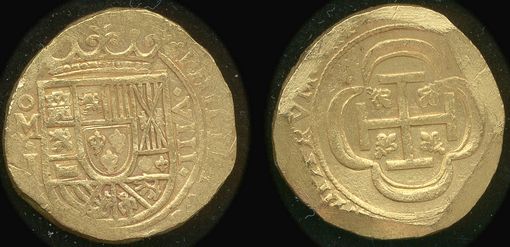
Florida State Collection, Bureau of Archaelogical Research (by permission)
This variety is unknown to many veteran collectors of 1715 Fleet Mexican cob gold. Florida State has two examples, including the one pictured below (FL # 11.00009). So far only one example has shown up in private hands (illustrated here). Originally in Schulman’s 1972 Spanish Galleon Sale (lot # 532), this clearly dated specimen reappeared in the 1977 Blauvelt-Fleet Sale. We suspect a few more examples exist, mis-attributed as 1715 onzas because of the large letters and stops. Even in the absence of a date, notice the clear 1714 style crown. Kent Ponterio, who first drew attention to this variety, calls this a “style of 1715” obverse, and indeed several features of the 1715 coinage are previewed on this coin. The large M used for the mint mark is the same M used on the 1715 onzas. Stops flank the denomination VIII, but in this case small square stops and not the large triangular stops standard in 1715. A square stop also separates the M and J (another may be below the J). On the two Florida State coins both obverse and reverse dies looks almost pristine.
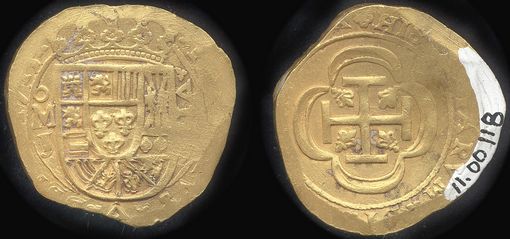
Florida State Collection, Bureau of Archaelogical Research (by permission)
Further confirmation that the Large M variety comes at the end of the 1714 mintage is found in the fact that the 5th reverse carries over into the 1715 mintage. See Florida State coin # 11.00118 pictured here. Reverse die diagnostics include a slightly detached upper lobe of the tressure and distinctive traditional fleurs in all quadrants. No other 1714 dies are known to carry over to 1715.
The most reasonable explanation of the Large M variety is that these coins are from dies cut late in 1714 (using the new punches for 1715) to handle a gold delivery that probably was not very large (sparing the cross die for re-use in 1715). If the calendar of the 1714 gold deliveries is eventually discovered, this is good coinage to match with a smallish December delivery. Another reason why these coins should be placed late in 1714, and in particular after the Royal dies issues, is because the Royals would not have been sacrificed to business production if the Large M dies had been available. Mexico City did not capriciously sacrifice very expensive Royal dies to produce business issues.
The Six Varieties of 1714 Onzas
We conclude that that the Mexican onzas of 1714 were struck with four obverse and five reverse dies. The obverse dies included a Royal die apparently pressed into service on an emergency basis when the normal 1714 obverse die unexpectedly failed. The first coinage of 1714 was the unsuccessful date-on-reverse issue, the final onza coinage was the brief Large M issue. Most of the 1714 coinage was likely struck with the so-called normal obverse. Five reverse dies were paired with these four obverses, including a Royal reverse die used when no other 1714 reverse was available. Cross dies with “jellyfish” fleurs pair with both the date-on-reverse obverse and the normal obverse. Cross dies with traditional fleurs pair with the date-over-GRAT recut obverse, the Large M obverse, and briefly with the normal obverse. The Royal reverse also uses traditional fleurs.
Addendum: a Unique Failed Royal of 1714
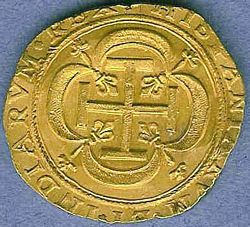
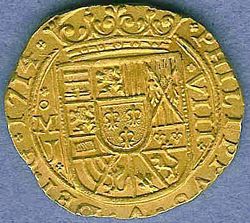
(courtesy DHL (Danny Lee))
Recently the 1714 onza shown here, the only one of its kind so far as is known, sold privately for more than $50,000. It is struck on both sides with the Royal dies for 1714 like the Variety 5 business strikes discussed above. Comparing it with the Variety 5 business strikes, however, immediately discloses some striking differences. Though out of round, it has the sharp detail and high relief of the full Royal and absolutely no doubling. Even at the very edge of the coin the lettering of the legends is sharp. The Variety 5 business strikes do not show this kind of sharpness anywhere on the coins and their legends are typically weak or absent. Fine detail and high relief come from multiple strikes. The absence of any doubling means the dies are held immobile in exactly the same position for multiple blows. This cannot be done with handheld dies. We do not yet have the testimony of a Mexico City coiner recounting how gold Royals were made, but some sort of simple screwpress must have been involved. The dies were locked in place and multiple blows were delivered to a specially prepared planchet until a round 35 mm coin was obtained. Sometimes, unfortunately, despite the best efforts of the coiners, the planchet did not expand uniformly to a round shape. Royals were struck without collars and continuing to strike a planchet that had gone significantly out of round was futile. That is what we have here, a coin being struck as a Royal, but a failed striking because the planchet went out of round. Close examination of the coin shows unmistakeable signs of multiple strikes.
Despite the lack of collars, you may ask, why should specially prepared rounded planchet go out of round? Because the planchet is not of completely uniform thickness and the gold expands more in thicker areas. To achieve uniform thickness the gold strip from which the planchet is to be trimmed must be run through a roller press once or twice. Likely Mexico City did not have a roller press in 1714 and had to rely on ad hoc methods of trying to uniformly flatten a planchet. Sometimes these worked, sometimes they didn’t. There was no way to tell until you struck the planchet several times. So what do you do with a special striking that fails to round? The present coin suggests that instead of remelting it you just release it as a business strikes.
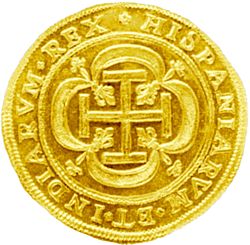
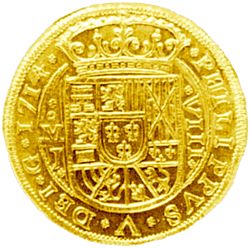
(courtesy Ponterio)
The magnificent Royal shown here was sold by Ponterio in 2000. The Florida State Collection also has a 1714 Royal onza (coin # 11.01319, pictured on Plate 10 of Craig). Careful measurement shows that these Royals are in fact not perfectly round. Diameters can vary by a millimeter on one coin. Other Fleet-era Mexican Royal onzas (1695, 1698, 1702) shows similar variations in diameter. This is to be expected given the method of manufacture that we have just outlined. We suspect the Mexican coiners had no set tolerance for rejecting out of round coins and relied instead on the appearance of the coin: if it looked out of round to the coiners it was rejected. Inevitably there must be other failed Royals besides the onza we have been discussing. Just this year a failed Royal for the 1714 one escudo has come to light. There likely are others.
References
Barriga Villalba, A.M., Historia de la Casa de Moneda, Bogota, 1969
Bowers and Ruddy Galleries, The Harold A Blauvelt, Iberoamerian & 1715 Spanish Treasure Fleet Collections, Los Angeles, 17-19 February 1977
Cespedes del Castillo, Guillermo, Las Casas de Moneda en los Reinos de Indias. Vol 1. Las Cecas Indianas en 1536-1825, Madrid, 1997
Craig, Alan, Spanish Colonial Gold Coins In The Florida Collection, Gainsville, 2000
Flemming, Philip, “The Gold Cobs of Mexico 1697-1732 Part I: The Jeweled Cross Issues of 1679-1699” in USMexNA journal, March, 2013
Lazo Garcia, Carlos, Economia Colonial y Regimen Monetario Peru: Siglos XVI-XIX., Lima, 1992
Schulman, Hans, Spanish Galleon Treasure, Schulman Coin & Mint, New York, 27-29 November, 1972
